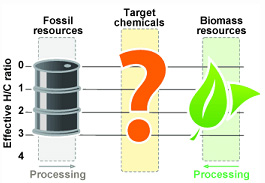Nov 13 2011
Our industrialized world is largely dependent on fossil resources, whether for the generation of energy, as a fuel, or as a feedstock for the chemical industry. The environmental problems related to this are known, and these resources will eventually run out.
In addition to wind, water, geothermal, and solar energy, biomass is also drawing increasing attention as a renewable resource. In an essay presented in the journal Angewandte Chemie, Esben Taarning and co-workers from the catalyst company Haldor Topsøe and the Lindoe Offshore Renewables Center (Denmark) describe how a sensible transition from petrochemicals to a chemical industry based on biomass might look.

To date, most of the biomass used by industry has been burned to generate energy. According to the authors, in the long term this is not the optimal use. “It is also not the most sensible solution to convert biomass into fuels,” says Taarning. “In the first place, the amount of biomass available does not meet the demand for fuels; in the second, the chemical characteristics of fuels and biomass are too different, so the processes would be too complex and uneconomical.” Means of transportation should be gradually switched to batteries or fuel cells.” Says Taarning: “In contrast, it really makes sense to use biomass as the feedstock for chemical industry. The available biomass should suffice to replace the fossil feedstocks used in the production of chemicals. The chemical characteristics of biomass and many bulk chemicals are also very similar, so the processes should be more economical than those for the conversion into fuels.”
When we do this, however, we need to diverge from the established value chains: instead of using brute force to convert these raw materials into specific platform chemicals that were originally selected because of their easy accessibility when starting from fossil resources, it would be better to use the interesting chemical characteristics already available in the biomass resources themselves and to optimize the use of favorable catalytic reaction pathways. “Through the clever selection of target chemicals it is possible to significantly increase the value added,” says Taarning. Because the development costs will be high and the first processes inefficient, it makes sense to initially concentrate on high-value products, thereby allowing for faster widespread adoption.
Also, many primary products and by-products of our current biofuel industry could be interesting platform chemicals in themselves: for example, ethanol as a starting material for the production of acetic acid, ethylene, and ethylene glycol, or glycerol for conversion into acrylic acid, a polymer precursor.
“The shift from a fossil-based chemical industry to one based on biomass poses many challenges,” says Taarning, “but the possibilities are also great: to develop a more sustainable chemical industry utilizing a more versatile feedstock supply and producing products with superior properties.”